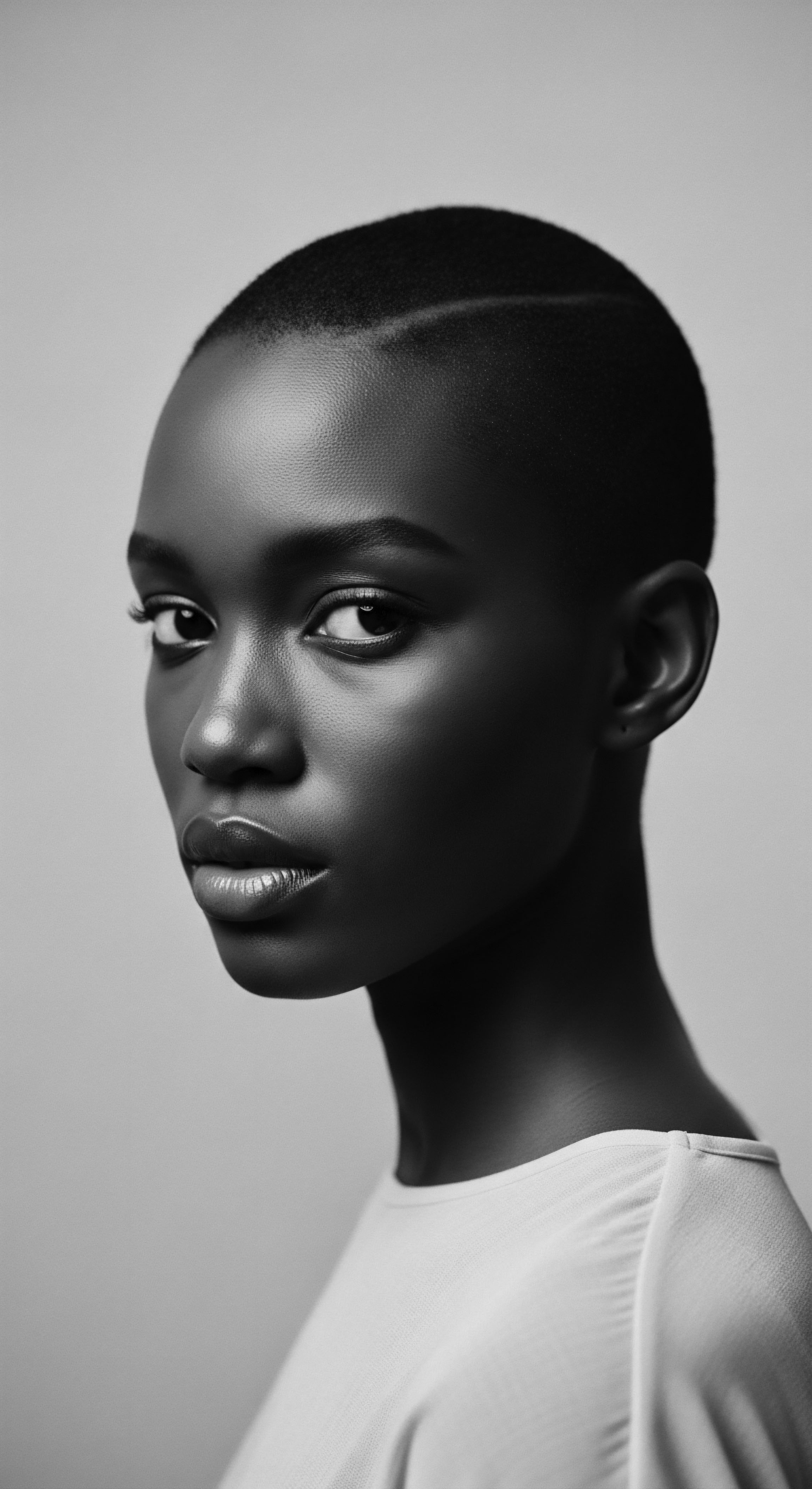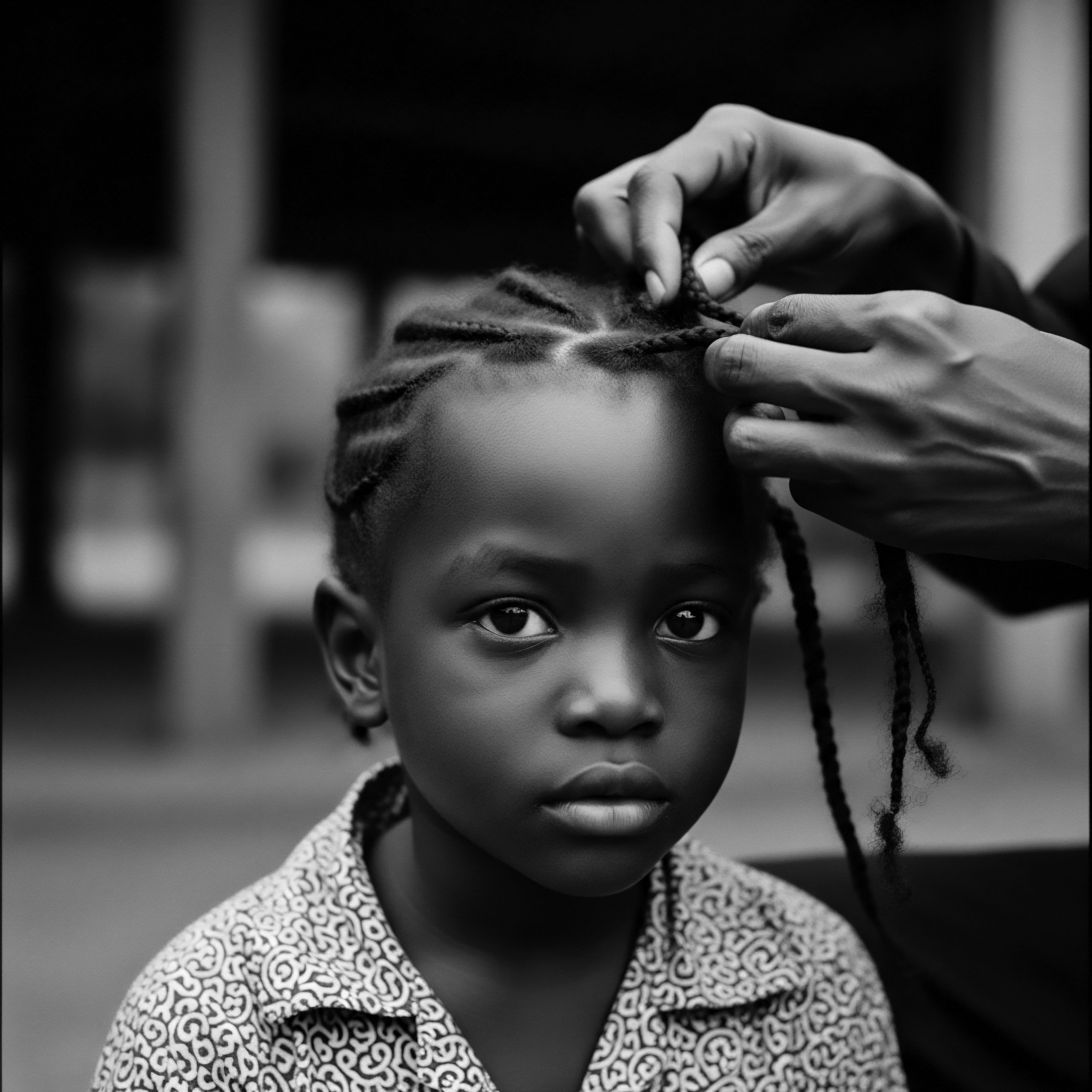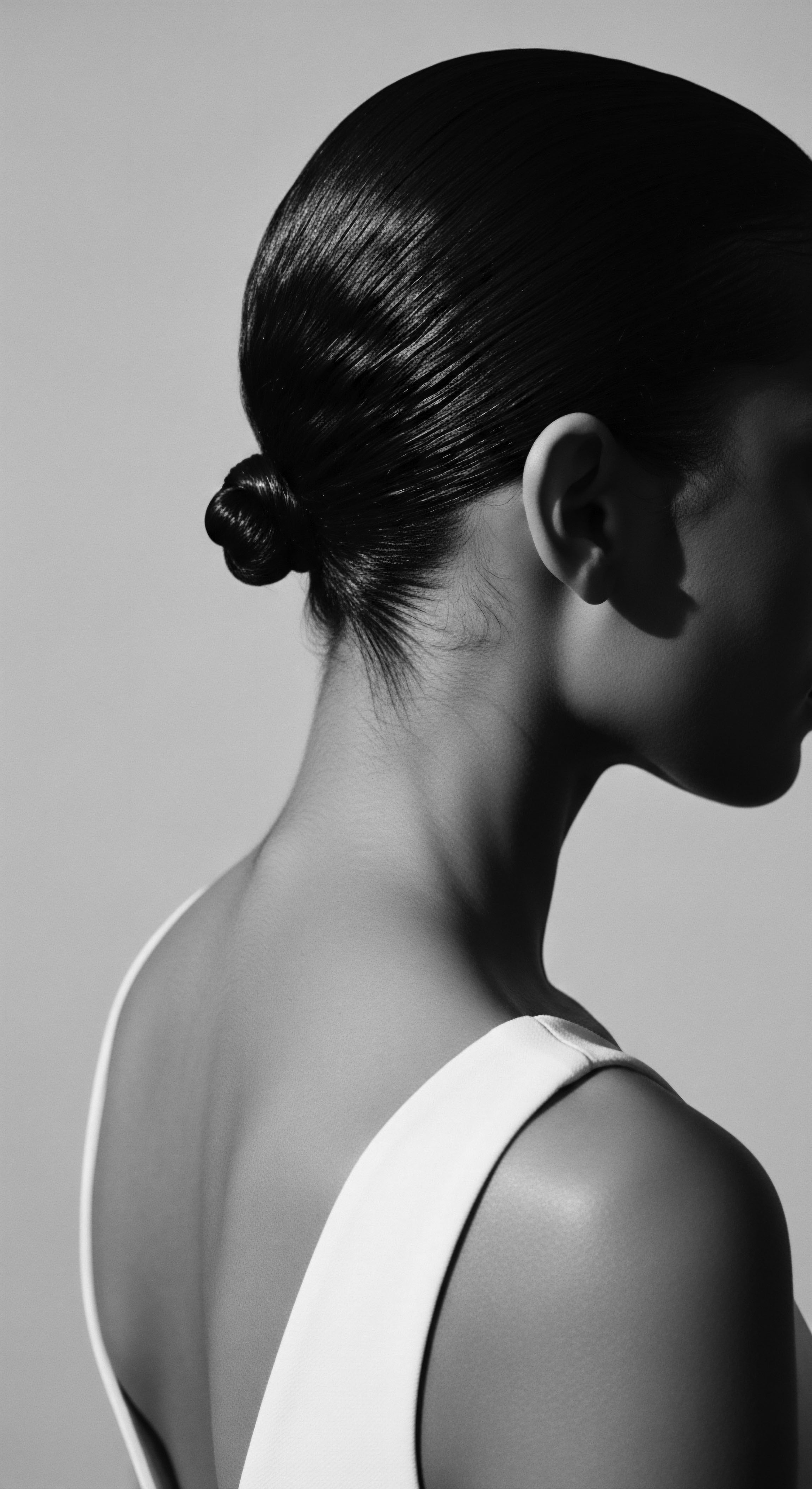
Roots
There exists a quiet wisdom in the very fibers that caress our crowns, a knowing passed through generations, resonating with the ancestral journey of textured hair. For many, the simple act of wrapping one’s hair at night, or donning a carefully crafted head covering before stepping out, was not merely a practical gesture; it was a profound act of preservation. This care, deep-seated in cultural heritage, holds a tangible connection to the structural integrity of each coil and kink. We speak now of how smooth fabrics, those gentle guardians, stand sentinel over the delicate architecture of textured hair, a practice rooted in time and an understanding that stretches back to the earliest moments of hair care.

Hair Fiber Architecture and Ancestral Understanding
The unique, often elliptical or flattened cross-section of textured hair strands, coupled with their varying degrees of curl pattern, creates a complex landscape. These contours are not just beautiful; they possess inherent vulnerabilities. Each bend, each curve, represents a point where the cuticle scales, those protective shingles lining the hair shaft, are naturally more lifted and exposed. This raised cuticle, while a hallmark of textured hair, makes it exquisitely susceptible to friction.
When these exposed cuticles rub against rough surfaces, they snag, lift further, and eventually chip away, leading to dryness, dullness, and breakage. Our ancestors, through keen observation and iterative practice, intuitively understood this delicate balance. They recognized that the coarse textures of everyday life – the rough-spun cloths, the unadorned sleeping surfaces – posed a constant threat to hair’s vitality. This observational knowledge, without the aid of modern microscopes, guided their choices of materials.
The choice of softer, less abrasive materials for hair contact began not as a luxury, but as an absolute requirement for sustaining hair health within communities whose very identities were often expressed through their hair. These early materials, perhaps finely prepared animal hides or carefully processed plant fibers, served as rudimentary yet effective smooth fabrics. The careful preparation of such natural elements for personal adornment and protection speaks to a deeply held reverence for hair’s well-being.
This attention to detail underscores a sophisticated understanding of hair’s physical needs, long before the terms “cuticle” or “cortex” entered our lexicon. It was a lived science, inscribed in daily rituals.

Hair Classification and Cultural Narratives
While modern hair classification systems attempt to categorize textured hair into numerical and alphabetical types, the rich cultural narratives surrounding hair far precede such taxonomies. In various West African societies, for example, hair was not simply an appendage; it was a living chronicle. Specific styles and adornments could indicate marital status, age, lineage, or even social rank. Protecting this sacred medium became paramount.
The understanding of how smooth fabrics contribute to this protection stems from a practical necessity to preserve these intricate, often time-consuming, expressions of identity. Rough contact would not only damage the hair itself but could disrupt the very meaning it conveyed. This practical knowledge, then, intertwined with the spiritual and social dimensions of hair.
- Aba ❉ A term used in some West African cultures, referring to the protective hair wrapping practices that shielded elaborate styles.
- Oshe ❉ A Yoruba concept, often relating to the artistry and spiritual significance of hair adornment, requiring careful preservation.
- Tignon ❉ A historical headwrap worn by Creole women in Louisiana, a practice rooted in legal constraint but transformed into an act of cultural expression, often involving fine fabrics to protect hair.

Early Care Practices and Material Choices
The earliest known attempts at hair protection likely involved natural elements readily available. Imagine the smooth, polished surfaces of certain gourds or the soft inner linings of plant leaves employed as early forms of hair wraps or containers. These choices were deliberate, reflecting an innate understanding that minimizing friction was a path to preserving hair’s sheen and strength. The evolution from these rudimentary methods to more sophisticated fabric creation marks a significant stride in hair care heritage.
The transition to woven materials, particularly those with a tight, flat weave, mirrored a growing sophistication in textile production, driven in part by the persistent need for hair safeguarding. This historical progression highlights how human ingenuity, driven by a foundational understanding of hair’s fragility, consistently sought smoother interfaces.
Smooth fabrics serve as silent guardians, preserving the integrity of textured hair through generations of wisdom.

Ritual
The daily and nightly care of textured hair, often framed as a regimen today, has always been a ritual, a profound engagement with self and ancestry. Within this continuum of care, the deployment of smooth fabrics holds a special place, acting as a tender bridge between historical practice and contemporary necessity. These materials play a silent, yet powerful, role in how hair is styled, maintained, and allowed to thrive, carrying forward a legacy of mindful protection.

Protective Styles Across Generations
For millennia, protective styles have formed a cornerstone of textured hair care. Braids, twists, cornrows, and buns were not merely aesthetic choices; they were strategic defenses against environmental aggressors and daily wear. Yet, even within these structured styles, the outer layer of hair remained vulnerable to friction. This is where smooth fabrics enter the picture, historically and presently.
The use of headwraps, caps, and bonnets made of fine, slick materials became an indispensable extension of these protective styles. These coverings allowed intricate coiffures to remain undisturbed for longer periods, preserving the tension, definition, and overall neatness of the style. This practice meant less manipulation, a critical factor in minimizing breakage for hair types prone to dryness and fragility.
Consider the elaborate hairstyles of ancient Nubia or the intricate braiding patterns of West African communities. Such creations, often taking hours, if not days, to complete, needed safeguarding. It stands to reason that coverings of finely spun cotton or perhaps even treated leathers with a smooth finish were utilized to preserve these artistic statements.
The continuity of this practice, from traditional headwraps to modern satin-lined bonnets, speaks to a deeply ingrained understanding of hair’s needs that transcends eras. This wisdom was not theoretical; it was lived experience, passed down through the hands of mothers, grandmothers, and community elders.

The Night’s Embrace ❉ Ritualized Hair Protection
Nighttime presents a unique challenge to textured hair. The tossing and turning against a rough cotton pillowcase can lead to a phenomenon akin to sandpaper rubbing against the hair shaft. Each microscopic interaction causes the cuticle scales to lift, tangle, and fray. This cumulative damage, occurring nightly, contributes significantly to dryness, frizz, and eventual breakage.
The traditional response to this persistent challenge was the nighttime covering, evolving over time to embrace truly smooth fabrics. The modern satin or silk bonnet, a ubiquitous item in many textured hair care arsenals, is not a recent invention; it is a direct descendant of ancestral wisdom.
These coverings act as a barrier, creating a frictionless environment for the hair. Instead of dragging and pulling against rough fibers, hair glides smoothly over the surface of satin or silk. This gentle contact preserves moisture within the hair shaft, as porous cotton is known to absorb moisture from hair. It also maintains the integrity of curl patterns, reducing tangles and frizz upon waking.
The ritual of preparing hair for sleep – perhaps sectioning, twisting, or pineapple-ing, then gently encasing it in a smooth fabric – is a daily affirmation of care, a quiet ceremony of preservation. It is a moment of conscious effort, linking individuals to a collective history of hair safeguarding.
| Era / Culture Ancient Kemet (Egypt) |
| Traditional Materials / Practices Linen headcloths, woven papyrus caps |
| Contribution to Hair Preservation Shielded hair from sun and sand; provided some friction reduction, especially finer linen. |
| Era / Culture West African Kingdoms |
| Traditional Materials / Practices Finely prepared plant fibers (e.g. raffia), animal hides, woven cotton wraps |
| Contribution to Hair Preservation Protected intricate styles; reduced environmental damage; smooth finishes minimized snagging. |
| Era / Culture 18th Century Creole Lousiana |
| Traditional Materials / Practices Tignon headwraps, often made of fine silks or satins |
| Contribution to Hair Preservation Preserved hair's moisture and style, defying restrictive laws through stylish protection. |
| Era / Culture Contemporary Black Diaspora |
| Traditional Materials / Practices Satin/silk bonnets, pillowcases, scarves |
| Contribution to Hair Preservation Minimizes friction, preserves moisture, reduces frizz and tangles, supports curl definition. |
| Era / Culture A continuous quest for smoother surfaces underscores a legacy of textured hair preservation. |

Traditional Tools and Modern Adaptations
The tools accompanying hair care have also evolved, yet their underlying principle often aligns with minimizing damage. Wooden combs, polished to a smooth finish, were preferred over rougher alternatives to glide through hair with less pulling. Similarly, the surfaces that hair rested upon or was covered by received careful consideration. The modern adaptation of traditional wisdom is clear in the prevalence of satin-lined caps and scarves.
These are not merely fashion accessories; they are functional artifacts of a sustained heritage of care. They stand as a testament to the fact that while styles and products may change, the fundamental principles of gentle handling and protection remain constant, echoing ancestral knowledge.
The quiet tradition of smooth fabrics is a nightly assurance, a continuation of care echoing through time.

Relay
To truly grasp how smooth fabrics stand as custodians of textured hair structure, one must delve into the very mechanics of hair’s existence. This understanding marries ancestral foresight with the illuminating lens of contemporary science, revealing a continuous relay of knowledge across generations. The safeguarding mechanism is not a mystery; it rests in the interplay of microscopic architecture and macroscopic interaction.

Microscopic Bonds and Macroscopic Preservation
Textured hair possesses a unique internal and external structure that renders it distinct from straight hair. Its elliptical shape means that the hair strand is not uniformly cylindrical. This variation in shape creates areas of tension and compression along the shaft, particularly at the curves and bends. At these points, the outermost protective layer, the cuticle, tends to lift more readily.
The cuticle is composed of overlapping scales, much like shingles on a roof. When hair is exposed to friction, these scales can abrade, snag, and chip away, exposing the inner cortex. The cortex, primarily made of keratin proteins, provides hair’s strength and elasticity, but it is also more vulnerable to moisture loss and structural degradation once the cuticle is compromised.
Smooth fabrics, such as silk or satin, function by presenting a low-friction surface to the hair shaft. Unlike rough cotton or other abrasive materials, silk and satin fibers are tightly woven and possess an inherently smooth, almost slippery quality. This allows textured hair to glide across the surface with minimal resistance. This gliding action means that the delicate cuticle scales remain flattened and undisturbed.
A study by Agrawal and Saha (2018) on textile friction properties noted that fabrics with a lower coefficient of friction significantly reduce mechanical stress on contacting surfaces, a principle directly applicable to hair fibers. This reduction in friction translates to less snagging, less pulling, and less lifting of the cuticle, thereby preserving the hair’s outer protective layer. When the cuticle stays intact, the hair retains its natural moisture more effectively, appears shinier, and is less prone to tangles and breakage.

The Science of Surface ❉ Friction and Fiber Integrity
The impact of friction on textured hair extends beyond just cuticle damage; it also affects the integrity of the hair’s internal disulfide bonds, which are critical for its strength and shape. Constant mechanical stress, even subtle rubbing, can weaken these bonds over time. This weakening leads to a loss of elasticity, making the hair more brittle and susceptible to snapping.
Smooth fabrics mitigate this by minimizing the physical stress exerted on the hair. Think of it as a gentle embrace rather than a constant tug.
This principle of surface interaction, intuitively understood by those who wrapped their hair in soft cloths centuries ago, now finds its validation in tribology – the science of friction, wear, and lubrication. The low friction coefficient of silk and satin materials acts as a buffer, preventing the microscopic tearing and pulling that leads to hair damage. This is particularly crucial for textured hair, which, due to its coiling structure, is naturally more fragile at its points of curvature. The preservation of these natural curves and the prevention of micro-tears are what truly safeguards the hair’s structure, allowing it to grow longer and stronger.
Consider the historical example of the use of Gele in certain West African cultures. Beyond their aesthetic and social functions, these elaborate head wraps, often crafted from intricately woven, sometimes even polished or starched, textiles, served a practical purpose. While not always made of silk or satin, the very act of wrapping and securing the hair, often with an underlying softer material or even a careful internal lining, created a micro-environment that reduced external friction.
This intentional layering and material selection, a testament to ancestral ingenuity, effectively extended the life and health of hair that was otherwise exposed to harsh elements and constant daily movement (Jones, 1999). This practice illustrates a sophisticated application of fabric protection, rooted in cultural wisdom long before modern scientific terms existed.

Echoes of Ancestry in Contemporary Care
The modern emphasis on satin and silk for hair protection reflects a continuous line of understanding, a relay from the ancestral past to the present. While the materials may have evolved in their refinement and accessibility, the fundamental insight remains the same ❉ that a smooth, non-abrasive surface is paramount for preserving the unique beauty and fragility of textured hair. This is why bonnets, scarves, and pillowcases made from these specific fabrics are not merely trends; they are scientifically validated extensions of time-honored practices.
They represent a conscious decision to protect, to nurture, and to honor the hair’s deep heritage by providing it with the gentlest possible environment. This care extends beyond the physical, touching upon a holistic appreciation for hair as a living aspect of identity and lineage.
The quiet science of low friction, understood through ancestral practice, actively preserves the life of each textured strand.

Reflection
The journey of understanding how smooth fabrics stand as guardians for textured hair structure is not merely an exercise in science or history. It stands as a profound meditation on a lineage of care, a testament to the enduring ingenuity born from necessity and affection. From the subtle rustle of a meticulously chosen plant fiber in ancient times to the gentle glide of a satin bonnet today, the essence of preservation remains constant. This is the very Soul of a Strand, recognizing hair not just as a physical entity but as a living archive of identity, resilience, and ancestral wisdom.
Each strand carries stories of survival, artistry, and an unyielding commitment to self-preservation. The simple act of choosing a smooth fabric, then, becomes a quiet yet powerful affirmation of this heritage, a continuation of a tender dialogue between past and present, ensuring that the unbound helix continues its journey, strong and revered.

References
- Agrawal, P. & Saha, A. K. (2018). Friction and Wear of Textiles ❉ An Overview. Textile Research Journal, 88(12), 1400-1413.
- Byrd, A. D. & Tharps, L. D. (2001). Hair Story ❉ Untangling the Roots of Black Hair in America. St. Martin’s Press.
- Gordon, K. F. (2006). The Cultural Context of Hair ❉ A Critical Review of the Literature. Journal of Black Psychology, 32(3), 329-346.
- Jones, J. (1999). The Gele ❉ Hair, Headwraps, and History in West Africa. Journal of African Cultural Studies, 12(1), 45-60.
- Mercer, K. (1994). Welcome to the Jungle ❉ New Positions in Cultural Studies. Routledge.
- Powell, K. (2013). The Science of Black Hair ❉ A Comprehensive Guide to Textured Hair Care. Self-published.
- Simone, S. (2007). Hair Care and Cosmetics ❉ A Practical Guide. Allured Publishing Corporation.
- Thompson, C. (2011). Good Hair ❉ The Styling Guide for the Natural Hair Community. Random House.
